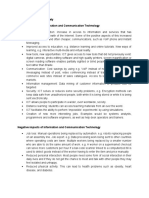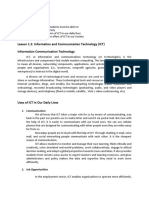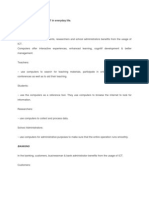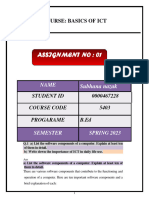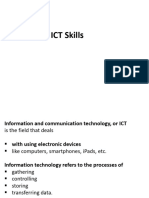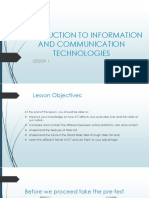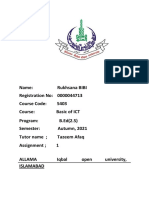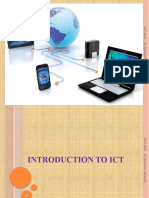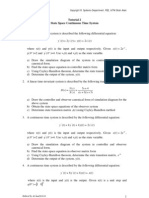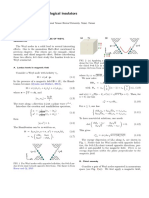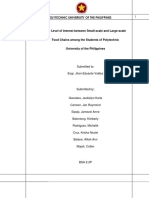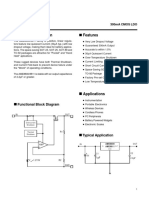QUESTIONS FROM SEATWORK 1
● What is the relevance of ICT in your chosen course?
- As a nursing student, ICT is very important because it helps in taking care of
patients better. It allows access to medical records, online books, and tools
that help nurses make the right decisions. ICT also makes it easier to
communicate with doctors and other healthcare workers. In hospitals,
computers and machines help in keeping track of patients’ conditions. ICT is
also useful for online learning, where students can study and watch medical
lessons
- Allow students to monitor and manage their own learning, think critically and
creatively, solve simulated real-world problems, work collaboratively, engage
in ethical decision-making, and adopt a global perspective towards issues and
ideas.
● Name at least 4 uses of ICT in your daily lives and explain
○ Communication
■ ICT takes a major role for us by means of communicating, way back in
the past our parents used to make letters and send them via post mail.
But now with the help of ICT it is easier to communicate with our loved
ones. We can use cellular phones that are designed for
communicating with other people even if they are miles away from
you.
■ Nowadays people are in touch with the help of ICT.Through
chatting,E-mail,voice mail and social networking people communicate
with each other. It is the cheapest means of Communication.
○ Job Opportunities
■ Employers expect their staff to have basic ICT skills. This expectation
even applies to job roles where ICT skills may not have been an
essential requirement in the past.
■ ICT enables organizations to operate more efficiently, so employing
staff with ICT skills is vital to the smooth running of any business.
Being able to use ICT systems effectively allows employees more time
to concentrate on areas of their job role that require soft skills.
○ Education
■ Can impact student learning when teachers are digitally literate and
understand how to integrate it into curriculum
■ Use a diverse set of lCT tools to communicate, create, disseminate,
store, and manage information
■ Replacing chalkboards with interactive digital whiteboards, using
students' own smartphones or other devices for learning during class
time
○ Socializing
■ The rapid and vast adoption of these technologies is changing how we
find partners,how we access information from the news, and how we
organize to demand political change.
AL-HAMAD, RAWAN C.
� ■ Young people can maintain social connections and support networks
that otherwise wouldn't be possible and can access more information
than ever before.
● Give 5 positive impacts and 5 negative impacts of ICT in society
○ POSITIVE IMPACTS
■ Increased access to information and services that has accompanied
the growth of the internet
■ Improved access to education. Ex. distance learning and online
tutorials, new ways of learning
■ Communication: Cost savings by using e.g. VolP instead of normal
telephone, email Imessage instead of post,video conferencing instead
of traveling to meetings, e-commerce websites instead of sales
catalogues
■ Helps resolve or reduce security problems; can keep data safe from
unauthorized people.
■ New tools, new opportunities: ICT gives access to new tools that did
not previously exist: digital cameras, photo-editing software and high
quality printers.
○ NEGATIVE IMPACTS
■ Job loss; robots replacing people on an assembly line.
■ Reduced personal interaction: Most people need some form of social
interaction in their daily lives and if they do not
■ Reduced physical activity: This can lead to health problems such as
obesity, heart disease, and diabetes.
■ A lot of ICT hardware and software is expensive, both to purchase and
to maintain.
■ Competition: this is usually thought of as being a good thing, butfor
some organizations being exposed to greater competition can be a
problem. If the organization is competing for customers, donations, or
other means of funding nationally or even internationally, they may
lose out to other organizations that can offer the same service for less
money.
QUESTIONS FROM SEATWORK 2
● Give at least two definitions of a computer
- A computer is a programmable machine
- Is an electronic device that manipulates information, or data
- It has the ability to store, retrieve, and process data
- Is a machine that manipulates data according to a list of instructions
(program)
- Is any device which aids humans in performing various kinds of computations
or calculations
AL-HAMAD, RAWAN C.
� ● What are the three principal characteristics of a computer?
- It responds to a specific set of instructions in a well-defined manner
- It can execute a pre-recorded list of instructions.
- It can quickly store and retrieve large amounts of data
● What are the 20 application of ICT in our daily lives and what is it used for?
1. Business
- Every business uses computers.
- They can store and maintain accounts, personnel records, manage
projects, track inventory, create presentations and reports.
- They enable communication between people within and outside the
business.
- Can help promote the business.
- Direct interaction with customers
2. Education
- Can be used to give learners audio-visual packages, interactive
exercises, and remote learning, including tutoring over the internet.
- Can be used to access educational information from internet sources
or via e-books
- Used to maintain and monitor student performance including the use
of online examinations
3. Healthcare
- Helps make it easier to store and access patient data, complex
information is also analyzed by software to aid discovery of diagnoses
- Help control lab equipment, heart rate monitors, and blood pressure
monitors
- Enable doctors to have information on the latest drugs and share info
to other medical specialists
4. Retail and trade
- Computers can be used to buy and sell products online
- Used for direct trading and advertising too, using sites such as eBay
and amazon.
5. Government
- Government departments use computers to improve the quality and
efficiency of their services.
- Ex. city planning, law enforcement, traffic, and tourism.
- Used to store information, promote services, communicate internally
and externally, as well as for routine administrative purposes
6. Marketing
- Enable marketing campaigns to be more precise through the analysis
and manipulation of data
- Facilitate the creation of websites and promotional materials
- Used to generate social media campaigns
7. Science
- Scientists; first groups to adopt computers as a work tool
- Used for research, sharing information with other specialists both
locally and internationally, as well as collecting, categorizing,
analyzing, and storing data.
AL-HAMAD, RAWAN C.
� - Play a vital role in launching, controlling and maintaining space craft
and operating advanced technology
8. Publishing
- Used to design pretty much any type of publication
- Used in the publishing of both hard-copy and e-books
- Used to market publications and tracks sales
9. Arts and Entertainment
- Used in virtually every branch of the arts, as well as in the wider
entertainment industry.
- Used to create drawings, graphic designs, and paintings
- Used to edit, copy, send and print photographs
- Used by writers to create and edit
- Used to make, record, edit, play and listen to music
- Used for playing games
10.Communication
- Made real-time communication over the internet easy
- Software and videoconferencing services such as Skype help families
connect with audio and video.
- Modern computers usually have microphones and webcams built-in
nowadays to facilitate software like Skype.
- Older communications technologies such as email are also still used
widely.
11.Banking and Finance
- Most banking in advance countries now takes place online
- You can use computers to check your account balance, transfer
money, or pay off credit cards
- Used to access information on stock markets, trade stocks, and
manage investments.
12.Transport
- Used to maintain safety and navigation systems, and increasingly to
drive, fly or steer.
- They can also highlight problems that require attention, such as low
fuel levels, oil changes, or failing mechanical part
13.Navigation
- GPS Technology
- Makes it easier to pinpoint your exact location, know which way that
you are moving on a map, and have a good idea of amenities and
places of interest around you
14.Working from Home
- Have made working from home and other forms of remote working
increasingly common.
- Can access necessary data, communicate, and share information
without commuting to a traditional office
- Managers are able to monitor workers productivity remotely
15.Military
- Are used extensively by the military.
- Used for training purposes, and analyzing intelligence data
AL-HAMAD, RAWAN C.
� - Used to control smart technology, such as guided missiles and drones
as well as tracking incoming missiles and destroying them
- Work with other technologies such as satellites to provide geospatial
information and analysis and aid communications.
16.Social and Romance
- Enables people to chat in text or audio in real time across large
distances, as well as exchange photographs, videos, and memes.
- Dating sites and apps help people to find romance.
- Online groups help people to connect with others who have similar
interests.
- Blogs enable people to post a variety of views, updates, and
experiences.
17.Booking Vacations
- Used by travelers to study timetables, examine route options, and buy
plane, train, or bus tickets.
- They can be used to explore and book accommodation, whether
traditional hotels,or through newer services, such as AirBnB.
18.Security and Surveillance
- Combined with other technologies to monitor people and goods.
Computers combined with biometric passports make it harder for
people to fraudulently enter a country or gain access to a passenger
airplane.
- Face-recognition technology makes it easier to identify terrorists or
criminals in public places
19.Weather Forecasting
- It's impossible for human beings to monitor and process all the
information coming in from satellite and other technologies, never
mind perform the complex calculations that are needed to predict what
is likely to happen in the future.
- Computers can process large amounts of meteorological information.
20.Robotics
- Is an expanding area of technology which combines computers with
science and engineering to produce machines that can either replace
humans, or do specific jobs that humans are unable to do.
- First use of robotics was in manufacturing to build cars. Since then,
robots have been developed to explore areas where conditions are
too harsh for humans, to help law enforcement, to help the military,
and to assist healthcare professionals.
IT ERA ADDITIONAL NOTES
● History of ICT
○ ICT, or information and communications technology (or technologies), is the
infrastructure components that enable modern computing. Although there is
no single,universal definition of ICT, the term is generally accepted to mean
all devices, networking components, applications and systems that combined
AL-HAMAD, RAWAN C.
� allow people and organizations (i.e., businesses, nonprofit agencies,
governments and criminal enterprises) to interact in the digital world
● Earliest Computers originally calculations were computed by humans, whose job title
was computers.
● These human computers were typically engaged in the calculation of a mathematical
expression.
● The calculations of this period were specialized and expensive, requiring years of
training in mathematics.
● The first use of the word "computer" was recorded in 1613, referring to a person who
carried out calculations, or computations, and the word continued to be used in that
sense until the middle of the 20th century
● Tally sticks
○ Tally stick was an ancient memory aid device to record and document
numbers, quantities, or even messages.
AL-HAMAD, RAWAN C.


